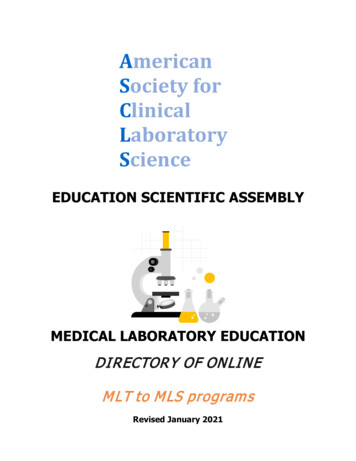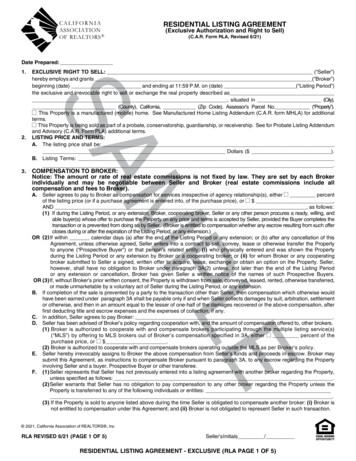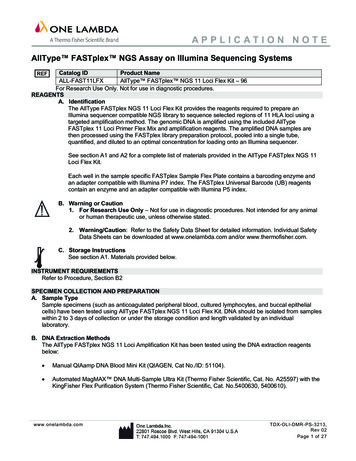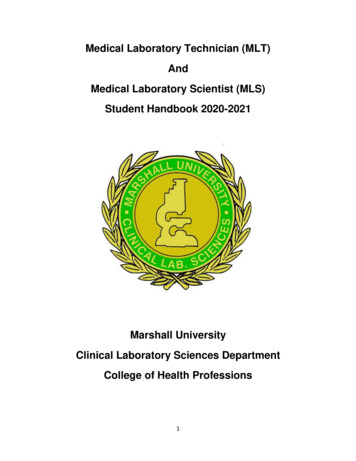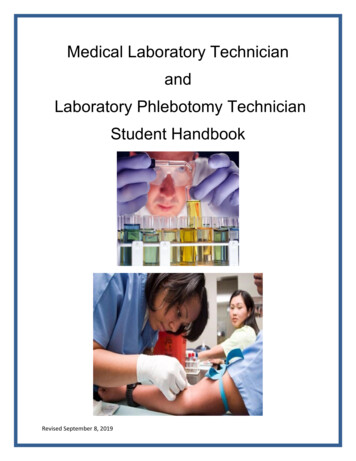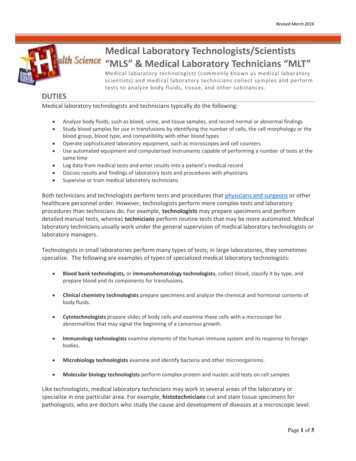
Transcription
Revised March 2016Medical Laboratory Technologists/Scientists“MLS” & Medical Laboratory Technicians “MLT”Medical laboratory technologists (commonly known as medical laboratoryscientists) and medical laboratory technicians collect samples and performtests to analyze body fluids, tissue, and other substances.DUTIESMedical laboratory technologists and technicians typically do the following: Analyze body fluids, such as blood, urine, and tissue samples, and record normal or abnormal findingsStudy blood samples for use in transfusions by identifying the number of cells, the cell morphology or theblood group, blood type, and compatibility with other blood typesOperate sophisticated laboratory equipment, such as microscopes and cell countersUse automated equipment and computerized instruments capable of performing a number of tests at thesame timeLog data from medical tests and enter results into a patient’s medical recordDiscuss results and findings of laboratory tests and procedures with physiciansSupervise or train medical laboratory techniciansBoth technicians and technologists perform tests and procedures that physicians and surgeons or otherhealthcare personnel order. However, technologists perform more complex tests and laboratoryprocedures than technicians do. For example, technologists may prepare specimens and performdetailed manual tests, whereas technicians perform routine tests that may be more automated. Medicallaboratory technicians usually work under the general supervision of medical laboratory technologists orlaboratory managers.Technologists in small laboratories perform many types of tests; in large laboratories, they sometimesspecialize. The following are examples of types of specialized medical laboratory technologists: Blood bank technologists, or immunohematology technologists, collect blood, classify it by type, andprepare blood and its components for transfusions. Clinical chemistry technologists prepare specimens and analyze the chemical and hormonal contents ofbody fluids. Cytotechnologists prepare slides of body cells and examine these cells with a microscope forabnormalities that may signal the beginning of a cancerous growth. Immunology technologists examine elements of the human immune system and its response to foreignbodies. Microbiology technologists examine and identify bacteria and other microorganisms. Molecular biology technologists perform complex protein and nucleic acid tests on cell samplesLike technologists, medical laboratory technicians may work in several areas of the laboratory orspecialize in one particular area. For example, histotechnicians cut and stain tissue specimens forpathologists, who are doctors who study the cause and development of diseases at a microscopic level.Page 1 of 5
Revised March 2016Technologists and technicians often specialize after they have worked in a particular area for a long timeor have received advanced education or training in that area.IMPORTANT QUALITIES Ability to use technology. Medical laboratory technologists and technicians must understandhow to operate complex machinery. Detail oriented. Medical laboratory technologists and technicians must follow exact instructionsin order to perform tests or procedures correctly. Dexterity. Medical laboratory technologists and technicians need to be skilled with their hands.They work closely with needles and precise laboratory instruments and must handle these toolseffectively. Physical stamina. Medical laboratory technologists and technicians may work on their feet forlong periods while collecting samples. They may need to lift or turn disabled patients to collectsamples for testing.EDUCATIONAn entry-level job for technologists usually requires a bachelor's degree in medical technology or lifesciences. A bachelor’s degree program in medical laboratory technology, also known as a medicallaboratory scientist degree, includes courses in chemistry, biology, microbiology, math, and statistics.Coursework emphasizes laboratory skills, including safety procedures and lab management.The courses may be offered through a university or hospital-based program that students attend duringtheir senior year of college. College graduates who major in other sciences and meet a program’sprerequisites, such as having completed required courses in biology and chemistry or maintaining acertain GPA, also may apply to a medical laboratory science program.Medical laboratory technicians often complete an associate’s degree program in clinical laboratoryscience. A limited number of 1-year certificate programs are available from hospitals, and admissionrequirements vary. The Armed Forces and vocational or technical schools also may offer certificateprograms for medical laboratory technicians. Technician coursework addresses the theoretical andpractical aspects of each of the major laboratory disciplines.Programs are accredited through the National Accrediting Agency for Clinical Laboratory Sciences(NAACLS) www.naacls.orgAccredited Schools in Virginia – Medical Laboratory Technician (MLT) Central Virginia Community College in corporation with Centra Health Systems, Inc – Lynchburg, VAJ. Sargeant Reynolds Community College – Richmond, VAo Danville Community College in partnership with J. Sargeant Reynolds Community CollegeNorthern Virginia Community College – Springfield, VATidewater Community College – Virginia Beach, VAWytheville Community College – Wytheville, VAo Mountain Empire Community College in partnership with Wytheville Community CollegePage 2 of 5
Revised March 2016Accredited Schools in Virginia – Medical Laboratory Technologist/Scientist (MLS) Inova Fairfax Hospital – Falls Church, VAAugusta Health – Fishersville, VASentara Rockingham Memorial Hospital School of Medical Laboratory Science – Harrisonburg, VANorfolk State University – Norfolk, VAOld Dominion University – Norfolk, VAVirginia Commonwealth University – Richmond, VAJefferson College of Health Sciences – Roanoke, VALicenses, Certifications, and RegistrationsSome states require laboratory personnel to be licensed. Requirements vary by state and specialty. Forspecific requirements, contact state departments of health, state boards of occupational licensing, orvisit The American Society for Clinical Laboratory Science.Certification of medical laboratory technologists and technicians is required for licensure in some states.Although certification is not required to enter the occupation in all cases, employers typically prefer tohire certified technologists and technicians.Medical laboratory technologists and technicians can obtain a general certification as a medicallaboratory technologist or technician, respectively, or a certification in a specialty, such ascytotechnology or medical biology. Most credentialing institutions require that technologists completean accredited education program in order to qualify to sit for an exam. For more credentialinginformation, visit the National Accrediting Agency for Clinical Laboratory Sciences.AdvancementAfter additional education, work experience, or certification, technologists and technicians mayspecialize in one of many areas of laboratory science, such as immunology, histotechnology, or clinicalchemistry. Some medical laboratory technicians advance to technologist positions after gainingexperience and additional education.WORK ENVIRONMENTMedical laboratory technologists held about 164,800 jobs in 2014. The industries that employed themost medical laboratory technologists in 2014 were as follows:Hospitals; state, local, and private58%Medical and diagnostic laboratories17Offices of physicians8Colleges, universities, and professional schools; state, local, and private5Medical laboratory technicians held about 163,400 jobs in 2014. The industries that employed the mostmedical laboratory technicians in 2014 were as follows:Hospitals; state, local, and private44%Medical and diagnostic laboratories19Offices of physicians12Colleges, universities, and professional schools; state, local, and private5Page 3 of 5
Revised March 2016Medical laboratory personnel are trained to work with infectious specimens or with materials that arecaustic or produce fumes. When they follow proper methods to control infection and sterilizeequipment, the risk decreases. They wear protective masks, gloves, and goggles for their safety.Technologists and technicians can be on their feet for long periods, and they may need to lift or turndisabled patients to collect samples.Work SchedulesMost medical laboratory technologists and technicians work full time. Technologists and technicianswho work in facilities that operate around the clock, such as hospitals and some independentlaboratories, may work evening, weekend, or overnight hoursJOB OUTLOOKEmployment of medical laboratory technologists is projected to grow 14 percent from 2014 to 2024,much faster the average for all occupations. Employment of medical laboratory technicians is projectedto grow 18 percent from 2014 to 2024, much faster than the average for all occupations.An increase in the aging population is expected to lead to a greater need to diagnose medicalconditions, such as cancer or type 2 diabetes, through laboratory procedures. Prenatal testing forvarious types of genetic conditions also is increasingly common. Medical laboratory technologists andtechnicians will be in demand to use and maintain the equipment needed for diagnosis and treatment.The number of individuals who have access to health insurance is expected to continue to increasebecause of federal health insurance reform. As a result, demand for the services of laboratory personnelmay grow as more patients who were previously uninsured, or found treatment to be cost-prohibitive,seek laboratory tests.Job prospects will be best for medical and clinical laboratory technologists and technicians whocomplete an accredited education program and earn professional certificationAVERAGE SALARYThe median annual wage for medical and clinical laboratory technologists was 59,430 in May 2014. Themedian wage is the wage at which half the workers in an occupation earned more than that amount andhalf earned less. The lowest 10 percent earned less than 40,640, and the highest 10 percent earnedmore than 82,180.The median annual wage for medical and clinical laboratory technicians was 38,370 in May 2014. Thelowest 10 percent earned less than 25,500, and the highest 10 percent earned more than 59,750.In May 2014, the median annual wages for medical laboratory technologists in the top industries in which theyworked were as follows:Hospitals; state, local, and private 59,530Medical and diagnostic laboratories 59,310Offices of physicians 55,590Colleges, universities, and professional schools;state, local, and private 53,610Page 4 of 5
Revised March 2016In May 2014, the median annual wages for medical laboratory technicians in the top industries in which theyworked were as follows:Hospitals; state, local, and private 39,050Offices of physicians 38,570Colleges, universities, and professional schools;state, local, and private 38,000Medical and diagnostic laboratories 37,360Most medical laboratory technologists and technicians work full time. Technologists and technicianswho work in facilities that are always open, such as hospitals and some independent laboratories, maywork evening, weekend, or overnight hours.Contacts for More InformationFor more information about medical laboratory technologists and technicians, visitThe American Society for Clinical Laboratory ScienceAmerican Society of CytopathologyFor a list of accredited and approved educational programs for medical laboratory personnel, visitNational Accrediting Agency for Clinical Laboratory SciencesFor information on certification, visitAmerican Association of BioanalystsAmerican Medical TechnologistsAmerican Society for Clinical PathologyO*NETCytogenetic Technologists CytotechnologistsHistotechnologists and Histologic TechniciansMedical and Clinical Laboratory TechniciansMedical and Clinical Laboratory TechnologistsREFERENCE Bureau of Labor Statistics, U.S. Department of Labor, Occupational Outlook Handbook, 2016-17 Edition, Medicaland Clinical Laboratory Technologists and Technicians, on the Internet m (visitedMarch 02, 2016).Explore Health er/28/Clinical Laboratory ScientistTechnician#Tab OverviewPage 5 of 5
The Armed Forces and vocational or technical schools also may offer certificate programs for medical laboratory technicians. Technician coursework addresses the theoretical and practical aspects of each of the major laboratory disciplines. Programs are accredited through the National Accrediting Agency for Clinical Laboratory Sciences
